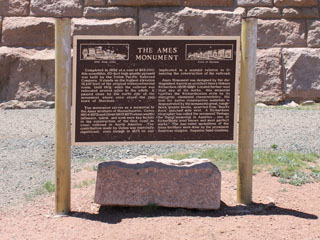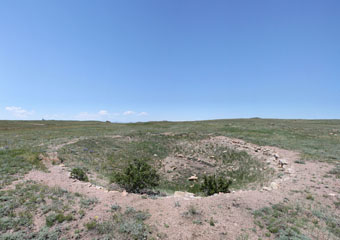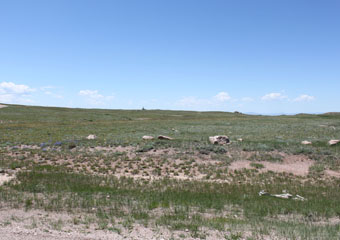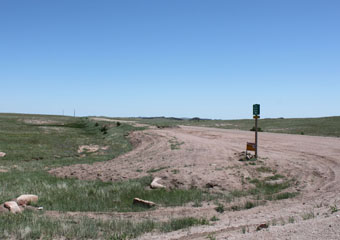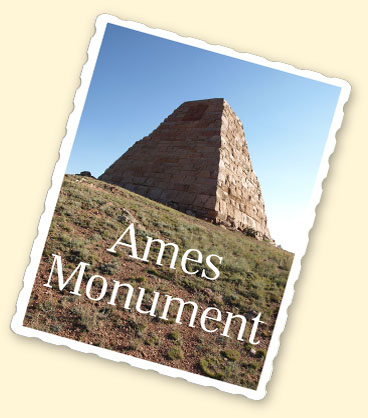

The Ames Monument is about eighteen miles east of Laramie or thirty-five miles west of Cheyenne, WY, depending on which direction you approach. It is reached down County Rd 234, about two miles from the Wedauwoo exit (Exit 329) off the I-80. County Rd 234 is a dirt road, but seems to be kept in pretty good condition. However, in winter, it may well be snow bound.
The pyramidal monument was erected by the Union Pacific Company in 1882 to honour brothers Oakes Ames and Oliver Ames, Jr., who both played major roles in financing and directing the company in its early years of operation. It was listed on the National Register of Historic Places in 1972, and the Union Pacific formally donated the monument to the state of Wyoming in 1983.

The monument is just off County Rd 234, also known as Monument Road, which runs up the left of the panoramic view above.
You can see a full, 360° flash panorama made from this
location by clicking on this link:
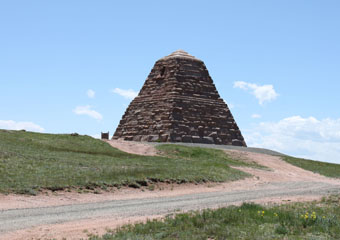
The monument's base stones are 5' tall by 8' wide, and the 60' long, 60' wide, 60' high monument narrows from the base by 4" for every foot in height. A ground level passage once existed through the monument but has long been sealed off.
The pyramid was designed by Henry Hobson Richardson from New York, NY, then one of the most acclaimed architects working in the eastern US.
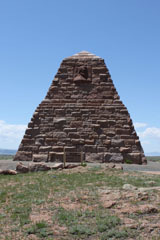

The east side (above left) bears a 9' by 9' bas relief of Oakes Ames. The west side (above right) features a relief of Oliver Ames Jr.
Richardson is now mainly remembered for his highly personal, medievally-inspired "Richardsonian Romanesque" style. Evidence of this in the Ames monument is the massing of the structure's profile, the rough hewn stone and the use of "random ashlar" or randomly jointed blocks.
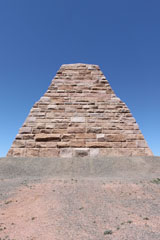
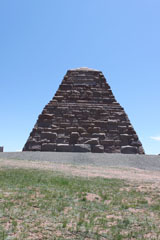
The south side (above left) is blank. The north side (above right) bears the words In Memory of Oakes Ames and Oliver Ames.
UP's Board of Directors voted in 1875 to erect the monument, and Richardson completed his design in 1879. The Norcross Brothers of Worcester, MA, began work in 1880 with eighty-five workers cutting stones from a local pink granite outcrop known as "Reed's Rock", and hauling them a half mile back by ox cart.
Saint-Gaudens moved to New York from Dublin with his parents when he was only six months old. He was apprenticed to a cameo-cutter there, but also took art classes at the Cooper Union and the National Academy of Design.
In 1867, he travelled to Europe to study in Paris and Rome, and returned to the US to achieve great critical and financial success through the design of monuments commemorating heroes of the American Civil War. He created many free-standing sculptures but was perhaps at his best with bas reliefs of the kind he produced for the Ames Monument.

The bas reliefs, each placed 39' from the base of the monument, were designed by the Irish-American sculptor Augustus Saint-Gaudens and cut from Quincy, MA, granite in his New York studio.
Like the monument, they have survived the harsh Wyoming weather well, although obviously used for occasional target practice by passing hunters: the tip of both brothers' noses have been shot away!
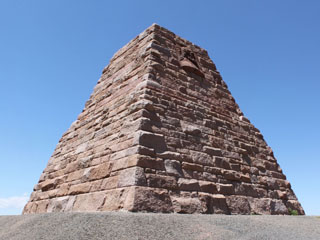
Saint-Gaudens was also interested in numismatics. He designed the $20 "double eagle" gold piece for the US Mint in 1905-1907, the $10 "Indian Head" gold eagle, and other commemorative medallions.
After retiring to Cornish, NH, in 1900 because of ill health, he founded the "Cornish Colony", an artistic colony that drew many notable painters, sculptors, writers and architects of the day.
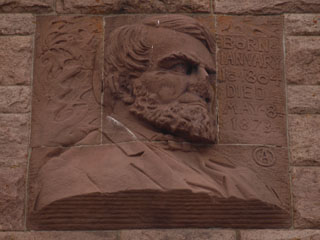
With his brother, Oliver Ames Jr., Oakes Ames (1804-1873), above, established the Massachusetts firm of Oakes Ames & Sons, based on his father's shovel manufacturing business. With America's westward expansion and the growth of British colonies, business boomed and the Ames made a large fortune.
Oakes was member of the US House of Representatives for Massachusetts and member of the committee on railroads. In 1865, the brothers became interested in the Union Pacific Railroad and invested heavily in a company called the Crédit Mobilier, the construction company and investment vehicle for the railroad.
The company was organised by T. C. Durant, Vice President of the Union Pacific, and engaged in questionable business practices in which a small group of financiers contracted with themselves and their associates to construct the railroad. They then charged inflated prices for their work and made large profits from the purchase of Union Pacific stocks at par value, which they sold on at market value.
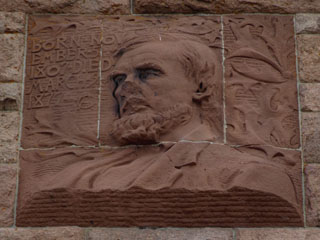
Oliver Ames, Jr. (1807-1877), above, became acting President of the Union Pacific in 1866 and was elected President from 1868 to 1871. Despite engineering difficulties, rough terrain, and labour problems, with his careful management, four-fifths of the line was built during his tenure as President. However, that success was marred by the Crédit Mobilier scandal, which erupted during his Presidency, although he was never implicated in the company's questionable practices.
In 1872, it was disclosed that Oakes Ames had sold Crédit Mobilier shares to fellow Congressmen at a price greatly below the true value of the stock. The subsequent scandal led to a House investigation, which found that the company had given discounted stock to more than thirty representatives on both sides of the House.
On February 28, 1873, the House passed a resolution formally censuring Oakes Ames "in seeking to secure congressional attention to the affairs of a corporation in which he was interested". He died soon after at North Easton, Massachusetts.
Oakes Ames had defended himself by claiming he was being purely patriotic, as the railroad was so important for national development. He also pointed out that he had not profited from the business dealings in question because the railroad was actually $6 million in debt when it was completed. In fact, many members of Congress and the public thought that, while he had engaged in legally compromising activities, he had not been consciously corrupt. Instead, an overriding desire to complete the Union Pacific project had perhaps clouded his judgment.
Although Oakes' reputation still remains suspect more than one hundred and thirty years later, the brothers' role in the Crédit Mobilier scandal was not quite as out of the ordinary as popularly thought, either then or now. Similar practices were not uncommon at the time and, in fact, they both gave unstintingly to make the Union Pacific a success through some of its toughest
crises.
Oakes put up nearly all his family's holdings to help capitalise construction of the railway, and Oliver provided a sure and steady hand as company President for five of its most challenging years. In its turn, the Congressional resolution against Oakes may partly have been driven by partisanship and the opportunity publicity surrounding a scandal offered to discredit a leading Republican.
In 1883, ten years after the scandal broke, and soon after dedication of the Ames Monument in Wyoming, the state legislature of Massachusetts finally passed a resolution vindicating Oakes Ames.
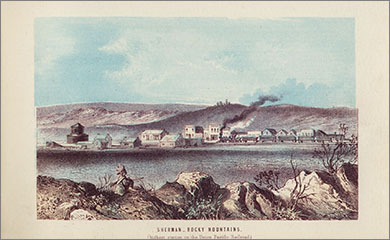
Above, "Sherman - Rocky Mountains" from Nelson's 1871 The Union Pacific Railroad: A Trip Across the North American Continent from Omaha to Ogden. Ames Monument is located on the hill directly above the locomotive chimney stack in this view. (You can browse this book from the books and manuals page of this website). On the left, you can see the five stall roundhouse rising above the yard, which also encompassed a turntable, two section houses and a windmill used to feed a water tank. As well as two hotels, two saloons, a general store, post office and schoolhouse, several hundred people lived in the township to service the railroad.
Trains were inspected here before starting their descent east towards Cheyenne or west across to the Laramie Valley. Crofutt's New Overland Trail noted in 1879 that, "Sherman, as a town, is not noted for its size. The trains stop here but a few minutes ... The freight taken on at this station for the East and West is quite extensive, consisting of sawed lumber, telegraph poles, and wood obtained in the hills and ravines but a few miles distant to the northward".
The settlement and station are long gone. The Union Pacific rerouted the grade about 3 miles south in 1901, after which the township quickly declined, although ghostly traces can still be found.

The monument stands 300' south and 32' above the highest elevation of the original tracks of the transcontinental railroad at 8,242' above sea-level. The panoramic view above is looking north from the base of the structure, and the old grade is still clearly visible, indicated by the dotted yellow lines.
Before the grade was rerouted south of the township, passengers were often allowed to leave their trains and inspect the monument. It was also reported that when construction was almost complete, some people were lifted to the top of the monument by a special rig to view the surrounding countryside for a hundred miles in all directions
The monument cost the Union Pacific $65,000, and the national importance of the transcontinental railroad and the part played by the Ames brothers in its construction was attested to by the attendance of President Rutherford B. Hayes at the monument's dedication in 1882.
There are more pages on this website showing other facets of the transcontinental railroad, including the Golden Spike Monument in Council Bluffs, IA, the Golden Spike Tower in North Platte, NE, Golden Spike NHS at Promontory, UT, the historic Central Pacific grade between Lucin and Promontory, UT, and the spectacular scenery where the line follows the Humboldt River at Palisade, NV.
Related Links:
Send a comment or query, or request permission to re-use an image.
An even-handed telling of the Ames brothers' involvement in the Union Pacific and Crédit Mobilier is found in the first volume of Maury Klein's Union Pacific, published by Doubleday in 1989 (click on the cover to search for these books on Bookfinder.com).

The Wyoming Recreation Commission's 1971 application for inclusion of the Ames Monument in the National Register is at:
pdfhost.focus.nps.gov/docs/NRHP/Text/72001296.pdf







